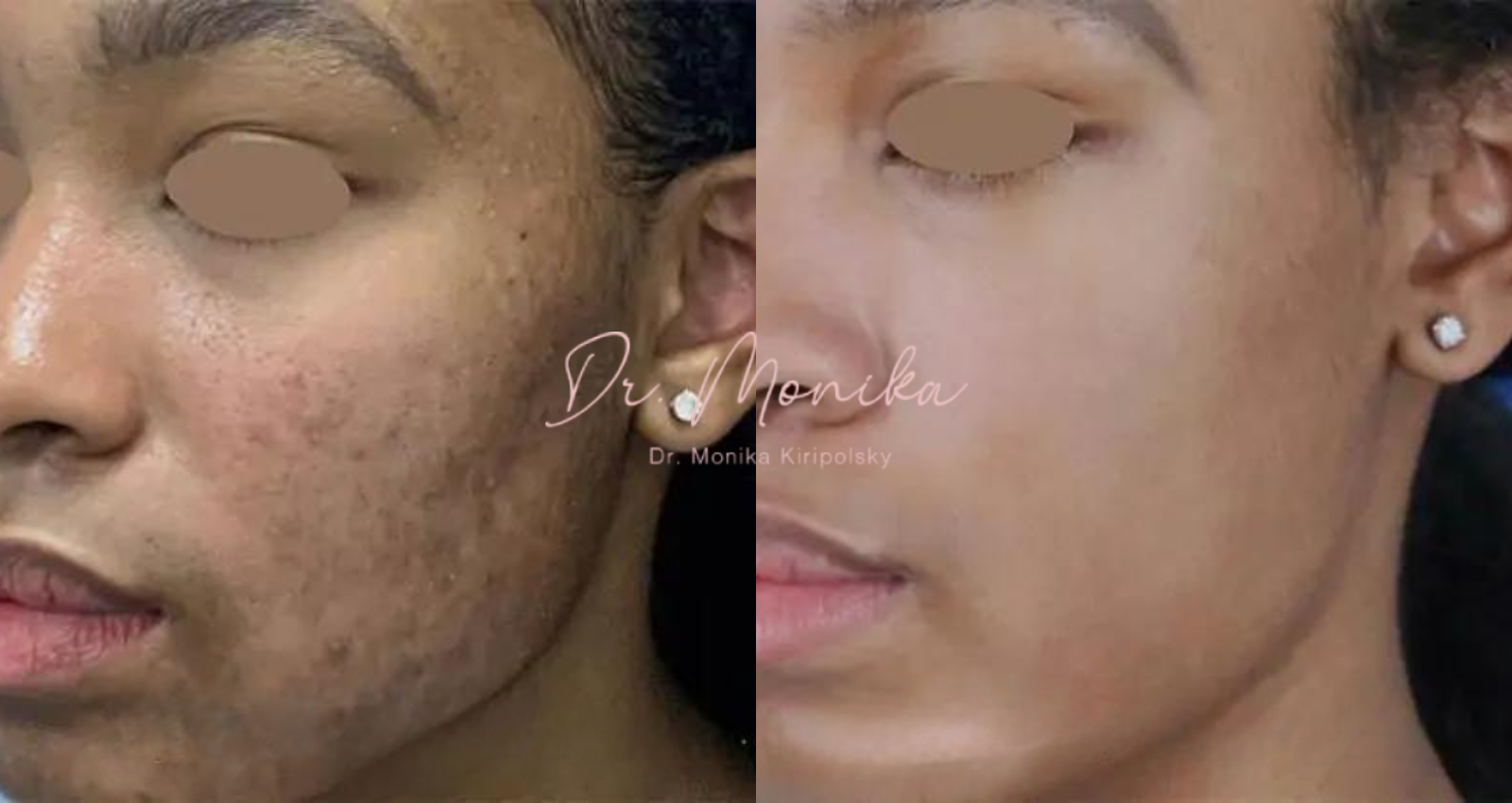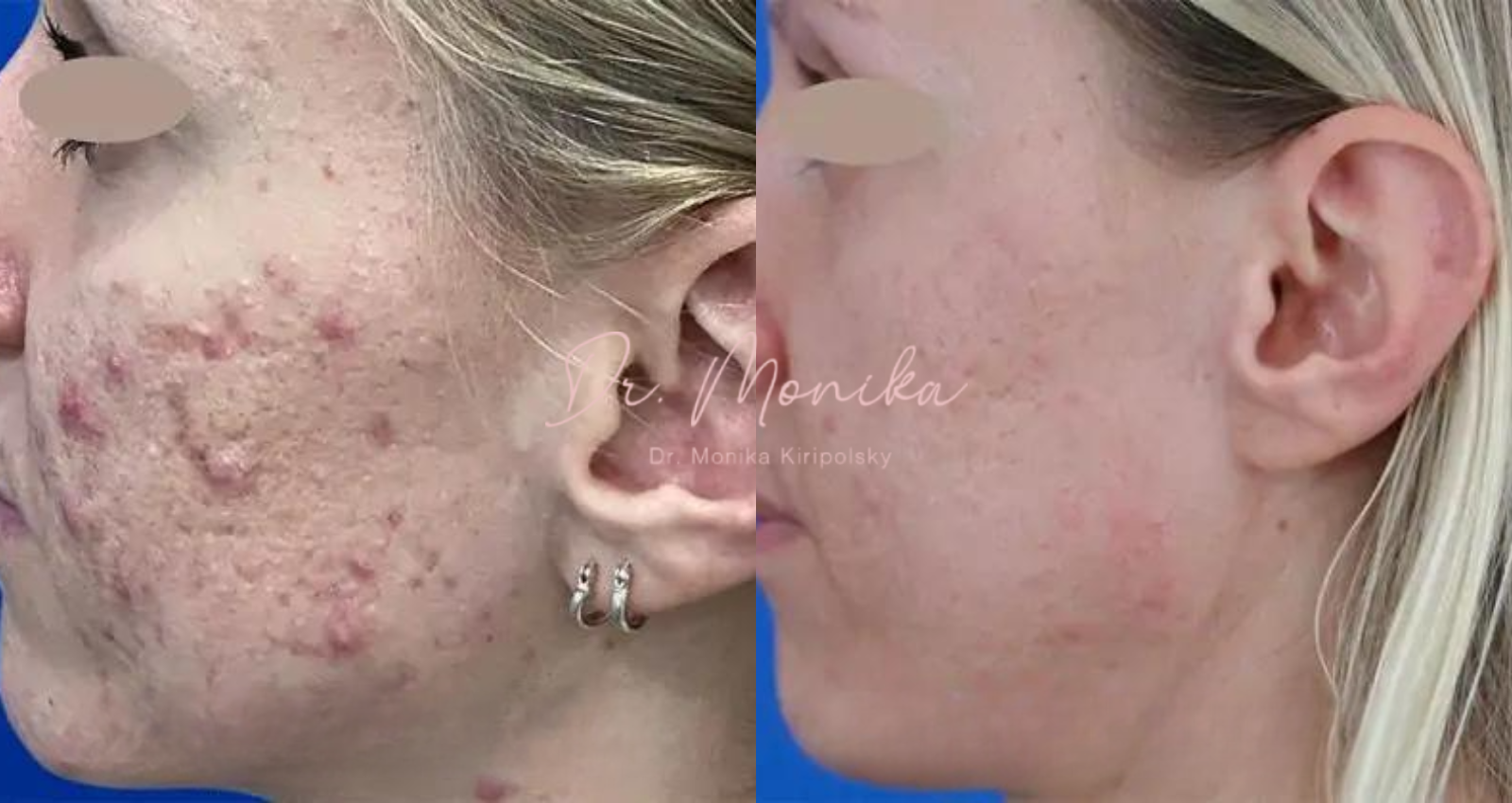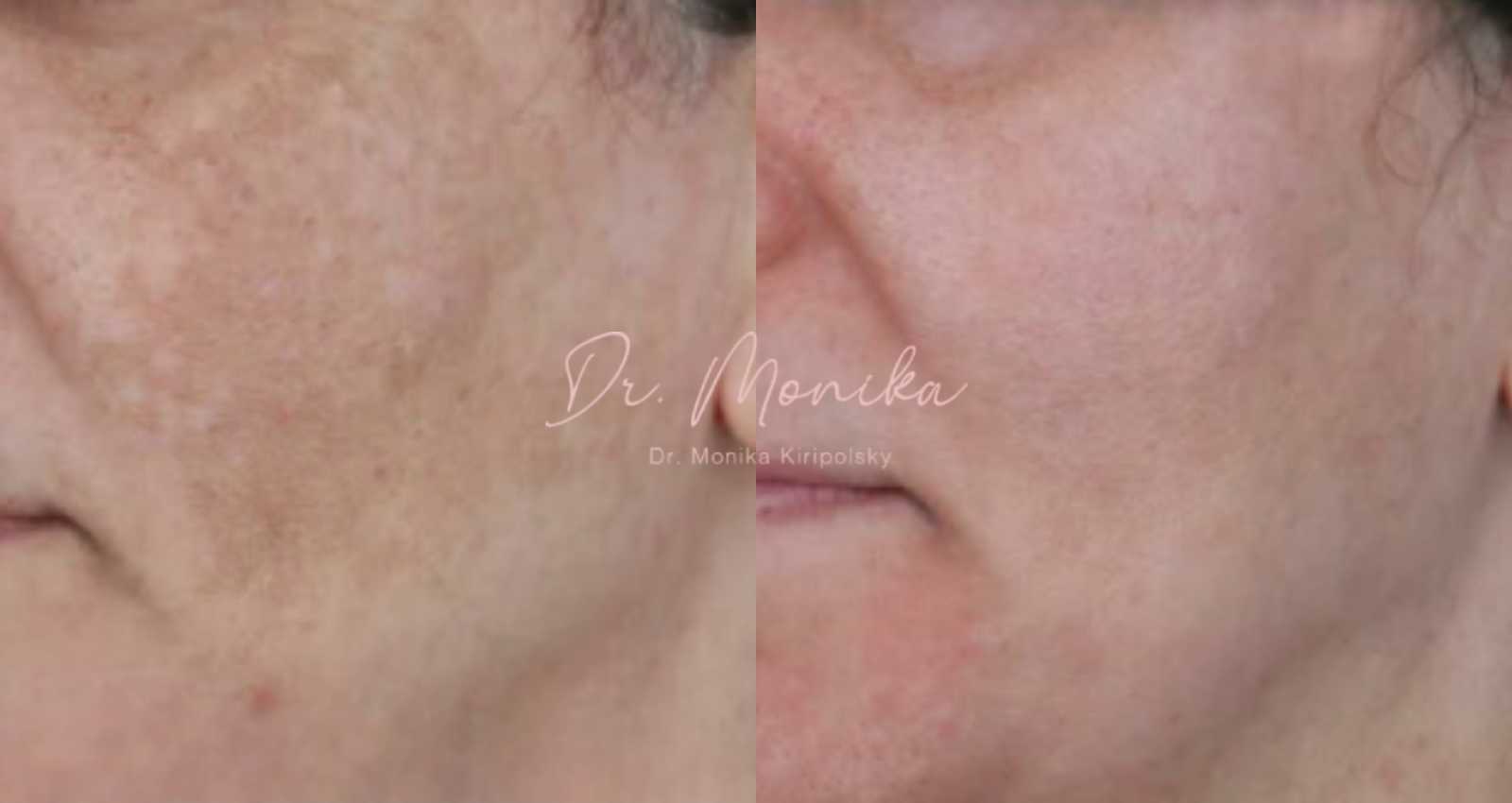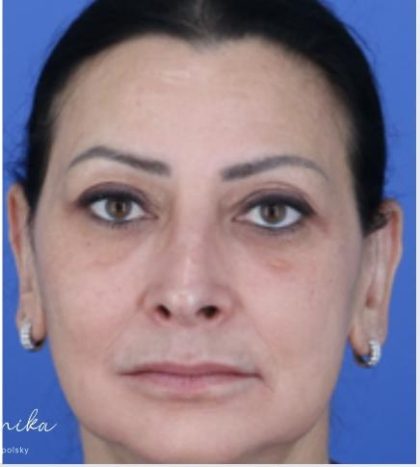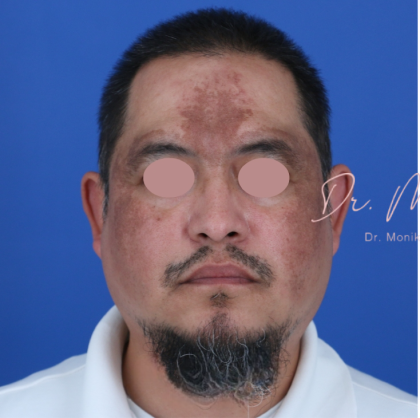Melasma
Conveniently located to serve the areas of Beverly Hills, Newport Beach and Los Angeles, CA

Melasma is an overproduction of pigment (melanin) by the skin cells in the affected areas. This skin pigment disorder typically presents as patchy brown areas on sun-exposed features like the forehead, cheeks, upper lip, nose, and chin. Even with minimal exposure to the sun, ultraviolet (UV) light makes these areas darker.
Female hormone fluctuations with age, pregnancy, birth control pills, and certain types of hormone therapy can all exacerbate the condition. Excessive exposure to heat and other inflammatory factors can also contribute. Melasma can be a challenging skin condition to treat, but some of the latest medical-grade topicals, chemical peels, and laser procedures can serve to revitalize patients’ complexion and confidence.
If you have yet to see results with over-the-counter remedies for melasma, consider booking a consultation with Dr. Monika Kiripolsky, located in one of the most well-known epicenters for cosmetic medicine, Beverly Hills. Dr. Kiripolsky is a board-certified dermatologist and fellowship trained laser and cosmetic surgeon. Her well-rounded education and experience give her the valuable tools she needs to provide exceptional results for every skin type.
To get started at her practice today, call (424) 652-6563 or fill out her contact form, and a staff member will be in touch with you shortly.
Contents
Before and After Photos
View More Photos
About Melasma
Melasma is occasionally referred to as “chloasma” or “the mask of pregnancy”, although it is oftentimes observed in people who are not pregnant. It can develop in people of all skin tones, but it is more common in those with darker skin than in those with fair skin. It is also far more common in women due to hormonal risk factors. According to research, about 50% of all patients with the condition have a family history of it, so there is a strong genetic component. It is also significantly linked to thyroid disease since individuals with this condition are four times more likely to develop melasma. (1)
To properly diagnose melasma, dermatologists need to closely examine the skin and confirm pigmentary issues with a Wood’s light- a UV device that highlights patchy discoloration- or a dermatoscope – a tool that magnifies skin characteristics without natural light reflections.
Can Melasma Be Cured?
Although studies have been able to find numerous associations, there is still no permanent cure for melasma. Still, managing the condition is feasible and patients can find a way to enjoy their skin without melasma discolorations. Alongside in-office treatment, staying out of the sun and/or applying sunscreen with an SPF of 30 or more is essential for a successful treatment.
Candidates
Dr. Kiripolsky’s approaches to melasma treatment are varied, and some approaches are more intensive than others. Most healthy people without a rash, infection, or lesion/s present in the areas of melasma are suitable candidates for topical treatments. Those with an autoimmune disorder, conditions that affect healing processes, or a history of keloid scarring should avoid laser and deep chemical peel procedures to treat their condition. Pregnant and breastfeeding patients should wait to have their baby before undergoing one of these intensive treatments. They may also have to refrain from oral medication or certain harsh topicals, like retinol or hydroquinone, and opt for a gentler means of minimizing their melasma.
Melasma Treatment Options
Topicals
Dr. Kiripolsky will first aim to significantly reduce melasma with topicals before resorting to more in-depth strategies with peels and laser sessions. She may prescribe hydroquinone, a skin-lightening agent that has been recognized as the standard in reducing melanin production, so it not only treats melasma but also freckles and other pigmentation issues related to sun exposure. (2) Retinoids are also an option; these Vitamin A-derived compounds serve to promote rapid skin cell proliferation, so the melanocytes (melanin-producing cells) and keratinocytes (cells that create the surface layer of the skin) have less contact with each other. (3)
For an antioxidant-rich serum for daily use, Dr. Kiripolsky may recommend Skin Brightening Pads, equipped with various healing and lightening ingredients. These pads contain topical vitamin C which serves as both a hyperpigmentation-fighting agent and an antioxidant, a compound that fights harmful free radicals that disrupt skin cellular processes. For oily skin, she may speak with you about using a product with salicylic acid to minimize oil production that contributes to microinflammation in the skin- a factor that causes more melanin production. Her Complexion Perfection Pads may be the best choice for this specific concern. All topical serums and treatments are medical-grade, so a consultation with Dr. Kiripolsky is essential. You can review the other various products available in her online store.
Sunscreen
As an individual with melasma, sunscreen should be an essential part of your daily skincare routine. Dr. Kiripolsky’s Tinted Antioxidant Mineral Sunscreen offers high-quality protection alongside several other skin benefits. Its chemical makeup is free of artificial fragrances, oils, gluten, sunscreen filters, and preservatives and is suitable for acne-prone skin. It contains vitamins E and C, antioxidants that combat other environmental free radicals other than UV light. Its light texture makes it the perfect water-resistant sunscreen that can also double as a makeup primer.
Chemical Peels
Chemical peels are acid-based topical treatments designed to provoke increased cellular turnover and remove dead skin cells to reveal healthier, clearer skin. They are highly customizable and can range from superficial to deep, providing differing levels of skin rejuvenation. Dr. Kiripolsky can alter the chemical makeup of a peel to even resolve a variety of aging concerns. Her formulation will greatly depend on the extent of your melasma and your skin type.
To treat your skin with a peel solution, Dr. Kiripolsky will first cleanse your skin of any debris, excess oil, and other impurities. Next, she will apply the liquid solution with a cotton pad or a brush. With superficial and medium peels, you may feel minor stinging and itching sensations, but with deeper peels, you will be anesthetized and unable to feel any discomfort. Once the peel completes its exfoliating process, she will apply a solution to neutralize the acid. In the days after your treatment, you will experience some peeling; the severity will greatly depend on how your skin reacts and the depth of the peel. Dr. Kiripolsky will provide you with aftercare guidance on how to get optimal results from this form of treatment.
Picosecond Laser
The picosecond laser targets and disables melanocytes over 3 to 5 treatments. Patients with melasma can expect to attain some results after just 2 treatments. As a fellowship-trained laser board-certified dermatologist, Dr. Kiripolsky has in-depth knowledge of laser technology and how it interacts with skin physiology. The laser emits a laser pulse every trillionth of a second (picosecond), creating faster, more precise results that promote minimal damage to the rest of the skin. For other pigmentation issues related to redness from broken capillaries and rosacea, Dr. Kiripolsky’s office is equipped with one of the most advanced lasers yet, the M22 Laser- administering light every billionth of a second.
Oral Medication
Some patients with acne struggles and oily skin may benefit from a short course of isotretinoin (Accutane) to minimize oil-related inflammation. Another option Dr. Kiripolsky prescribes regularly is oral tranexamic acid, a medication that inhibits melanocyte activation by impeding plasminogen activator enzymes. (4) Although the medication is not as popular in the U.S., many other countries have researched it as an alternative to topical treatments.
Personal Consultation
A personal consultation with Dr. Kiripolsky will help you gain clarity on which approach is best to address your melasma. During this meeting, she will assess your skin and the extent of your skin darkening and ask about your aesthetic desires and your commitment to treatment. She will be sure to answer your questions thoroughly and educate you on daily skincare to keep your skin as glowy and clear as possible.
If you are in the Beverly Hills or Los Angeles area and would like to discuss treatment options for melasma, call Dr. Kiripolsky’s office at (424) 652-6563 or request to schedule your appointment online. Regardless of your concerns, she will take into consideration your medical history, the treatments you have tried so far, and your skin type and tone to help you attain the long-lasting results you have been searching for.
Cost of Melasma Treatment
The cost of your melasma treatment will depend on Dr. Kiripolsky’s recommendations and the length of your treatment regimen. She will most likely begin with topical methods and progress to lasers and/or chemical peels depending on the severity of your condition. She will provide you with a total cost estimate during your consultation and can review your financing options if you would like to cover the cost with affordable monthly payments.
FAQ
Why do I have brown spots on my skin?
Brown spots on the skin, also known as hyperpigmentation, can be a common concern for many individuals. Hyperpigmentation refers to areas of the skin that are darker in color than the surrounding skin due to an excess of melanin production. Several factors can contribute to the development of brown spots, including melasma, age spots, sunspots, liver spots, freckles, post-inflammatory hyperpigmentation, hormonal changes, excessive sun exposure, genetics, skin trauma or injury, certain medications, hormonal imbalances, pregnancy, and the aging process.
Can you cure melasma?
Melasma is a skin pigment disorder that cannot be cured, but it can be well-managed with lifestyle changes and skin treatments. Patients can attain clearer, blemish-free skin utilizing various topical creams and serums, laser sessions, and even chemical peels. With the cessation of treatment, patients’ melasma reoccurs.
Can pregnant women treat their melasma?
Some products may not be suitable for pregnant women, but they can manage their brown patches with daily sunscreen and other gentler methods. These women should wait until after breastfeeding before considering a melasma treatment.
Which laser is most effective for melasma?
Melanin-targeting lasers like the picosecond and nanosecond lasers are best for targeting the root cause of melasma.
References
- Basit H, Godse KV, Al Aboud AM. Melasma. PubMed. Published 2023. https://www.ncbi.nlm.nih.gov/books/NBK459271/#:~:text=Melasma%20is%20a%20common%20skin
- Schwartz C, Jan A, Zito PM. Hydroquinone. PubMed. Published 2020. https://www.ncbi.nlm.nih.gov/books/NBK539693/
- Bandyopadhyay D. Topical treatment of melasma. Indian Journal of Dermatology. 2009;54(4):303. doi:https://doi.org/10.4103/0019-5154.57602
- Godse K, Sarkar R, Mysore V, et al. Oral Tranexamic Acid for the Treatment of Melasma: Evidence and Experience-Based Consensus Statement from Indian Experts. Indian Journal of Dermatology. 2023;68(2):178-185. doi:https://doi.org/10.4103/ijd.ijd_266_22


